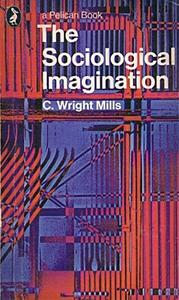Take a photo of a barcode or cover
informative
slow-paced
C. Wright Mills’s 1959 book, The Sociological Imagination, is one of the most important sociology books of the 20th century. While this book is famous to many Introduction to Sociology students as it coins the concept, the sociological imagination, I would argue that its importance is that it acts like a harbinger that effectively brings into question one line of thought in favor of another.
While this book is relatively short, there is so much packed into this book ranging from an expansion of what the sociological imagination means, to what is in response to. The sociological imagination can be defined as a ‘tool” that enables us to “grasp history and biography and the relations between the two” (page 4). It differentiates ‘history’ (the broad social structure and its evolution) from ‘biography’ (individual experiences), and delineates ‘troubles’ (personal issues) from ‘issues’ (public phenomena affecting society at large). Mills uses examples like unemployment, war, marriage, and urban life to illustrate the differences between personal troubles and broader societal issues, demonstrating how the sociological imagination can bridge the gap between individual experiences and larger social dynamics.
What is more, the sociological imagination is a concept not constructed in a vacuum but in response to what Mills saw as the main currents in sociology during the mid-twentieth century. This includes theorists like Talcott Parsons and Paul Lazarsfeld. To Mills, Parsons, is associated most notably “grand theory” or the attempt to describe the functioning of society as a whole. To Mills, grand theory is extremely abstract, too concerned with the grammar, rather than the substance of language, and void of power relations and conflict. Lazarsfeld, on the other hand, is associated with what Mills calls “abstracted empiricism,” which is a type of sociology, that he contends places methodological technique above all else. These techniques are largely based on surveys and statistical analysis, and while impressive in terms of their size, lack depth and fail to engage with broader social and historical contexts. Moreover, he notes such methods have sought to replicate the natural sciences and have thus focused more on developing a “philosophy of science,” rather than helping to engage with and solve pressing social issues. In all, this abstracted empiricism has brought about the bureaucratization of the field, where sociologists are more specialized components, rather than independent, creative thinkers.
Throughout the book, Mills builds on these critiques, while at the same time making a call for a return to a more historically-based sociology that brings together concrete social issues with large-scale structures and processes. It is no surprise that following this book, along with the postmodern turn, we saw a demise in the abstract, ahistorical studies of people like Parsons and Lazarsfeld.
While this book is relatively short, there is so much packed into this book ranging from an expansion of what the sociological imagination means, to what is in response to. The sociological imagination can be defined as a ‘tool” that enables us to “grasp history and biography and the relations between the two” (page 4). It differentiates ‘history’ (the broad social structure and its evolution) from ‘biography’ (individual experiences), and delineates ‘troubles’ (personal issues) from ‘issues’ (public phenomena affecting society at large). Mills uses examples like unemployment, war, marriage, and urban life to illustrate the differences between personal troubles and broader societal issues, demonstrating how the sociological imagination can bridge the gap between individual experiences and larger social dynamics.
What is more, the sociological imagination is a concept not constructed in a vacuum but in response to what Mills saw as the main currents in sociology during the mid-twentieth century. This includes theorists like Talcott Parsons and Paul Lazarsfeld. To Mills, Parsons, is associated most notably “grand theory” or the attempt to describe the functioning of society as a whole. To Mills, grand theory is extremely abstract, too concerned with the grammar, rather than the substance of language, and void of power relations and conflict. Lazarsfeld, on the other hand, is associated with what Mills calls “abstracted empiricism,” which is a type of sociology, that he contends places methodological technique above all else. These techniques are largely based on surveys and statistical analysis, and while impressive in terms of their size, lack depth and fail to engage with broader social and historical contexts. Moreover, he notes such methods have sought to replicate the natural sciences and have thus focused more on developing a “philosophy of science,” rather than helping to engage with and solve pressing social issues. In all, this abstracted empiricism has brought about the bureaucratization of the field, where sociologists are more specialized components, rather than independent, creative thinkers.
Throughout the book, Mills builds on these critiques, while at the same time making a call for a return to a more historically-based sociology that brings together concrete social issues with large-scale structures and processes. It is no surprise that following this book, along with the postmodern turn, we saw a demise in the abstract, ahistorical studies of people like Parsons and Lazarsfeld.
informative
I felt the most connected to the appendix of this text — weird feeling but still happy about its value. As for the main text, I felt a little disconnected and confused at times. Part of this was likely due to listening to the audiobook (at a higher speed, of course lol) and a disconnect from the historical/sociological context. Upon reading a synopsis after finishing, I realized that I understood the text fine but was expecting a deeper through-line that wasn’t really present. Thinking I had missed that imperative, I had a sense of unease that I wasn’t grasping the big picture as I digested. In reality, the main thrust is a concept I already hold fundamentally; the importance of the sociological imagination, aka the ability to think outside our individual selves and connect to communities around us, thinking more deeply and less short-sightedly (narrowly). The appendix was really what I loved, however. It gave great advice (that I strive to follow eventually lol) to create an informal portfolio of notes and ideas from engagement in the field. I’d like to apply that but will need to dedicate myself to the task since it takes an added layer of energy and commitment. I know it would be highly valuable and useful to reference for future work though.
challenging
informative
inspiring
reflective
slow-paced
A clear manifesto of what sociology should be. Partly outdated, partly (and sadly) still very relevant today, and above all a great introduction to the field of sociology.
informative
slow-paced
informative
reflective
medium-paced
informative
reflective
fast-paced
Pocos libros son tan retadores intelectualmente como este. Escrito en prosa clara y directa, Wright Mils propone a la imaginación sociológica como la facultad redentora del quehacer del científico social.
Until the final words of the appendix, this is a reactionary textbook with little relevance to those who are not studying or meaning to study sociology. Not being a student of the discipline, it was uninteresting and long-winded, but I also can’t weigh in on its relevance to the subject (which, if the afterword has anything to say, is great). Simply not my cup of tea.







